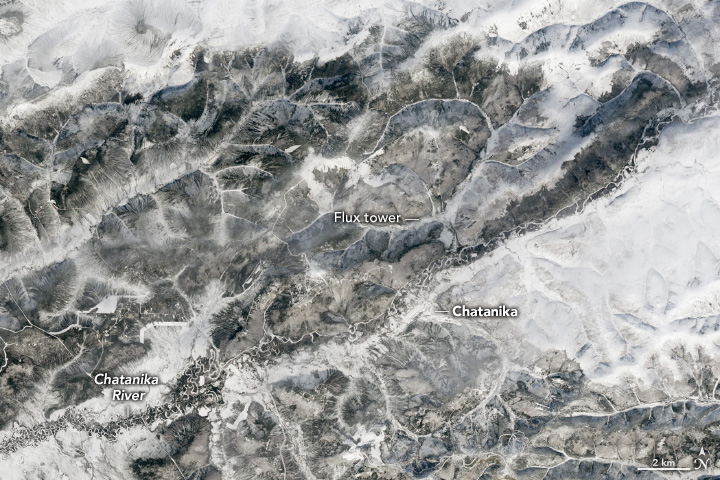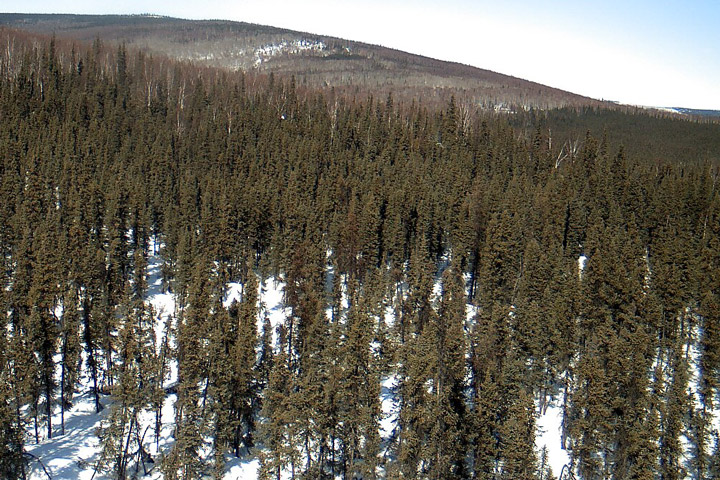
A Boreal Forest Awakens
Downloads
- above_oli_2023109_lrg.jpg (1831x1221, JPEG)
- Fluxtower_pho_2023109.jpg (720x480, JPEG)
- Fluxtower_pho_2023144.jpg (720x480, JPEG)
Metadata
- Sensor(s):
- Landsat 8 - OLI
- Data Date: April 19, 2023
- Visualization Date: May 25, 2023
Interior Alaska in spring is a place of transitions: snow and ice begin to melt, temperatures rise, and animals emerge from hibernation. Even the trees begin to “wake up.”
To observe this awakening of the boreal forest, scientists with NASA’s Arctic Boreal Vulnerability Experiment (ABoVE) traveled to Fairbanks, Alaska, in April 2023. They arrived with a suite of instruments designed to detect the onset and rate of photosynthesis—an indication that a tree has begun its seasonal growth. Writing in a blog post about the fieldwork, Fred Huemmrich and Petya Campbell, scientists at the University of Maryland, Baltimore County, explained why they wanted to collect this information.
“The timing of the start of the growing season is key to determining the overall productivity of the forest and can be a useful predictor of possible stress events later in the summer,” they wrote. “One of the goals of our project is to find ways to use light to detect when these evergreens ‘turn on’ photosynthesis in the spring and actively start taking up carbon from the atmosphere.”
Part of the work involved traveling to a “flux tower” about 20 miles northeast of Fairbanks. With existing instruments on the tower, and new ones installed during the field campaign, scientists can determine the rate of photosynthesis and relate that activity to the forest’s light levels, moisture, and temperature.
The site of the tower, near the community of Chatanika, is visible in the image at the top of this page. It was acquired on April 19, 2023, with the Operational Land Imager (OLI) on the Landsat 8 satellite. Notice that there was still plenty of snow on the ground.


That same day, a camera on the flux tower acquired the photograph above (top). It shows the forest toward the end of the scientists’ fieldwork, which ran from April 6–20, 2023. At the time, temperatures generally stayed below freezing and the tree’s needles had not yet become photosynthetically active. The second photograph shows the same area about a month later, on May 24. By that date, the snow had melted, temperatures had warmed, and the evergreen forests had “woken up.”
“We are able to see that change in our tower reflectance measurements as well,” Huemmrich said. The team plans to return to the area in July 2023 to make similar measurements during the height of forest’s summer productivity.
References & Resources
- NASA (2023) Arctic Boreal Vulnerability Experiment. Accessed May 26, 2023.
- NASA Earth Observatory, Notes From the Field (2023, May 18) Illuminating a Boreal Forest’s Spring Wake-Up. Accessed May 26, 2023.
- NSF/NEON Caribou-Poker Creeks Research Watershed NEON / BONA. Accessed May 26, 2023.
- PhenoCam (2023, May 26) NEON.D19.BONA.DP1.00033. Accessed May 26, 2023.
NASA Earth Observatory image by Wanmei Liang, using Landsat data from the U.S. Geological Survey. Digital camera images are from the PhenoCam Network. Story by Kathryn Hansen based on materials from Fred Huemmrich and Petya Campbell/UMBC.
This image record originally appeared on the Earth Observatory. Click here to view the full, original record.